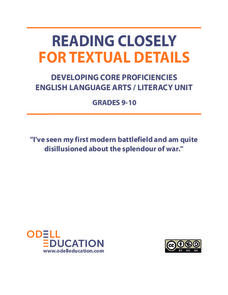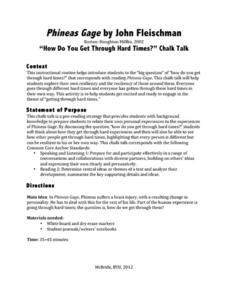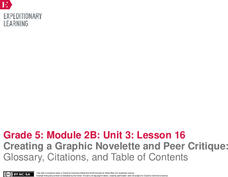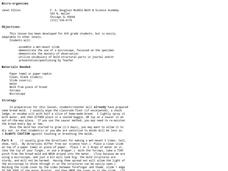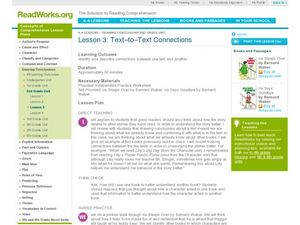Curated OER
Introduce Vocabulary: Franklin Goes to the Hospital (Bourgeois)
Franklin the turtle is on another adventure in Paulette Bourgeois' book Franklin Goes to the Hospital, and there are plenty of new words for your young readers to explore as they hear this story. Although you can include more,...
Curated OER
Introduce Vocabulary: Hot Air: The (Mostly) True Story of the First Hot-Air Balloon Ride (Priceman)
What a fun way to explore new vocabulary words! Marjorie Priceman's book Hot Air: The (Mostly) True Story of the First Hot-Air Balloon Ride offers plenty of new words for scholars to learn in context: amateur, assembled,...
EngageNY
Grade 9 ELA Module 2, Unit 2, Lesson 3
The manipulation of time is one of the most essential elements in Sophocles' Oedipus the King. As your language arts class participates in a jigsaw discussion activity, they work together to analyze the play's plot structure and...
EngageNY
Using Multiple Resources of Information: Creating a Cascading Consequences Chart about DDT and Practicing a Fishbowl Discussion
For every action there is a consequence. Scholars continue their work on creating a cascading consequence chart about DDT using Welcome Back, The Exterminator, Rachel Carson: Sounding the Alarm on Pollution along...
EngageNY
Mid-Unit 3 Assessment, Part I: Short Constructed Response and Organizing Notes for a Public Speech
It's time to put pen to paper. Scholars complete the first part of the mid-unit 3 assessment, writing a short constructed response about international aid following a natural disaster. Next, pupils use informational texts and note...
Curated OER
Fact or Fantasy?
Are we alone in the universe? This brief informational text on extraterrestrial theory has been split into seven sections to help scholars practice note taking. They read the statements, underlining key words. Then, using the graphic...
Odell Education
Reading Closely for Textual Details: Grades 9-10
Pay close attention! After finding details in a picture, scholars begin to find details in videos and text. They work together in groups, discuss in pairs, and carry out independent reading to answer guiding questions. Organizers, tools,...
Curated OER
What is Proofreading?
Is your essay coherent? Does it make sense? Is it formatted correctly? Does it adhere to standard English conventions? This helpful and informative slide-show walks learners step by step through the editing and proofreading process. Each...
Curated OER
Phineas Gage: “How Do You Get Through Hard Times?” Chalk Talk
Hold a discussion in writing about coping strategies to prepare your pupils for reading Phineas Gage: A Gruesome but True Story About Brain Science by John Fleischman. After journaling, pupils come up in an organized fashion and write...
EngageNY
Creating a Graphic Novelette and Peer Critique: Glossary, Citations, and Table of Contents
A, B, C ... let's alphabetize to get organized! Using the informative resource, scholars create an alphabetized glossary of key words for their graphic novelettes. Additionally, they create a table of contents and citations page.
K5 Learning
Rhyming Animals
Second graders read an informational text passage on animals, as well as a poem that incorporates rhyming words. Then, 2nd graders answer questions based on what they read.
Curated OER
The Struggle to End Apartheid
Motivate your class with this worksheet on apartheid. After responding to several pre-reading questions, learners read and mark 2 articles: 1 about the Soweto Uprising and 1 about Nelson Mandela. They then respond to 4 short answer...
Curated OER
Character Wheel
Explore a story's character by using this character wheel. Kids will love this graphic organizer. It's easy to use, and there are spaces to write character traits and textual evidence that supports those traits. This is a great middle...
Curated OER
Asking and Answering Lower-Level Questions
Help your kindergartners with reading comprehension using this simple sentence strips approach. They answer basic questions about a simple sentence, determining the who and what of the story. Use the graphic organizer...
Curated OER
What Was Columbus Thinking?
Why is Christopher Columbus one of the most studied figures in history? Upper graders will investigate why Christopher Columbus traveled to the New World and what happened to the native people he encountered. They read and discuss...
Curated OER
SEQUENCING A STORY WITH PICTURES: TEXT AND TALK
Third graders create a graphic organizer. They draw illustrations that show the beginning, middle and end of a trip they took to visit a friend or a relative. They write age-appropriate text to accompany each drawing. They tell...
Curated OER
Text Structures in Science Writing
Students recognize that science writing is organized in identifiable patterns called text structures. Understanding and using these different text structures help refine students' abilities to read and write in science.
Curated OER
English Exercises: Fast Food Goes Organic
In this vocabulary and listening skills online learning exercise, students complete a crossword puzzle with the names of fast foods that are shown in clip art pictures. They watch a YouTube video about a fast food restaurant becoming...
Curated OER
Organic Chemistry
In this organic chemistry worksheet, learners determine the relationships between compounds. Students use Newman Projections to draw stable conformations for compounds. This worksheet has 6 problems to solve.
Curated OER
Problem-Solving Strategy: Make an Organized List
In this problem-solving worksheet, students make an organized list to solve 5 mathematical word problems. Students show their work on the worksheet.
Curated OER
Nonfiction Text elements
Young scholars research Lewis and Clark and use the information for a book. In this Lewis and Clark lesson, students gather information and complete worksheets in an activity to write a book. Young scholars use a variety of...
Curated OER
Micros-organisms
Sixth graders examine mold with a microscope. In this micro-organisms lesson, 6th graders use teacher-prepared mold samples to prepare a wet-mount slide and examine the mold under a microscope then draw and label what they see.
Curated OER
Identifying When Using Evidence from the Text
First listen to the story The Meanest Thing to Say and then answer question regarding when the story takes place. Using evidence from the text, text clues and pictures to order events and find the time frame of the story is what this...
Curated OER
Text-to-Text Connections
Help youngsters make connections between two different texts. They read two stories about the same character, Ira Sleeps Over and Ira Says Goodbye. They discuss how the character of Ira acts in each of the stories, how he...
Other popular searches
- Organizing Text
- Identify Text Organization
- Text Organization Patterns
- Organizing Text Information
- Types of Text Organization
- Text Organizational Patterns
- Reading Text Organization
- Organizing Text Sequence
- Author Text Organization
- Types Text Organization
- Science Text Organization
- Ways of Organizing Text






